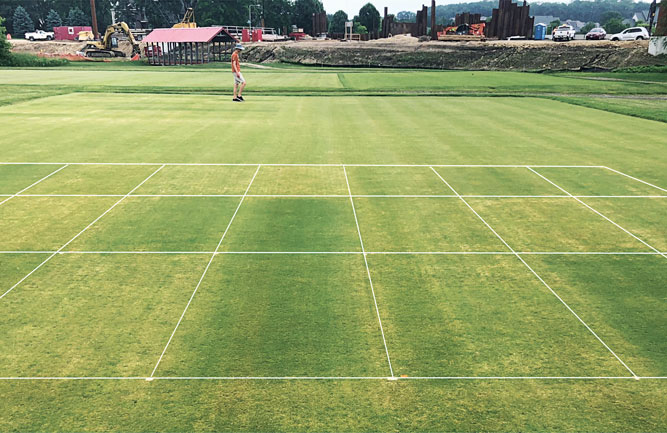An integrated nutritional, chemical approach to Poa annua control
By Nathaniel F. Reams, Xunzhong Zhang, Ph.D. and Erik Ervin Ph.D.

Image of the 2.0x rate FeSO4 plots in early May 2013, at the beginning of Year 3 of the trial. The darkest and most Poa-free plot (foreground) was also treated with paclobutrazol. The middle plot also received seaweed extract, while the background plot is FeSO4 alone. Photo: Nathaniel F. Reams, Xunzhong Zhang, Ph.D. and Erik Ervin Ph.D
Poa annua suppression and control in creeping bentgrass putting greens is a perennial challenge in many temperate climates. A nutritional approach to Poa annua control is frequent use of sulfates of iron and ammonium to provide plant nutrition plus gradual rootzone acidification. Also common is the repeated application of paclobutrazol to selectively injure Poa annua throughout the growing season.
The ultimate goal is a smooth transition to mostly creeping bentgrass, without sudden stand collapse. Our objective was to apply very high foliar rates of FeSO4, in combination or not with paclobutrazol or seaweed extract, and determine effects on Poa annua populations in a creeping bentgrass putting green over time.
The trial is on a mature sand-based putting green, originally seeded with Penneagle creeping bentgrass but now consists of 50 to 65 percent Poa annua. Main plots were foliar FeSO4 rates of 0, 0.25, 0.50, and 1.0 lbs. per 1,000 sq. ft. (0, 0.5x, 1.0x and 2.0x rates, respectively) applied every two weeks from March through October. Main plots are split by seaweed extract (4.0 oz. per 1,000 sq. ft.) or paclobutrazol (22.3 percent a.i. at 0.50 oz.) (spring and fall) and 0.25 oz. (summer) per 1,000 sq. ft. on the same application schedule. Nitrogen was supplied to all plots uniformly via ammonium sulfate at 1.8 lbs. N per 1,000 sq. ft. per year. Initial soil pH at 1.0 inch was 6.22. FeSO4 treatments had no effect on soil pH at the end of Year 1. The 1x and 2x FeSO4 rates reduced Poa annua to 11 percent and 9 percent, respectively, by the beginning of Year 2, but seaweed extract had no effect. Adding paclobutrazol to the 1x and 2x FeSO4 rates decreased Poa annua from 20 percent (paclobutrazol-alone) to between 3 and 5 percent. Preliminary results indicate that season-long application of high rates of foliar FeSO4 have the potential to significantly reduce Poa annua in CB putting greens.
Nathaniel F. Reams, Xunzhong Zhang, Ph.D., and Erik Ervin Ph.D., Virginia Tech University. Reams can be reached at nreams@vt.edu.










